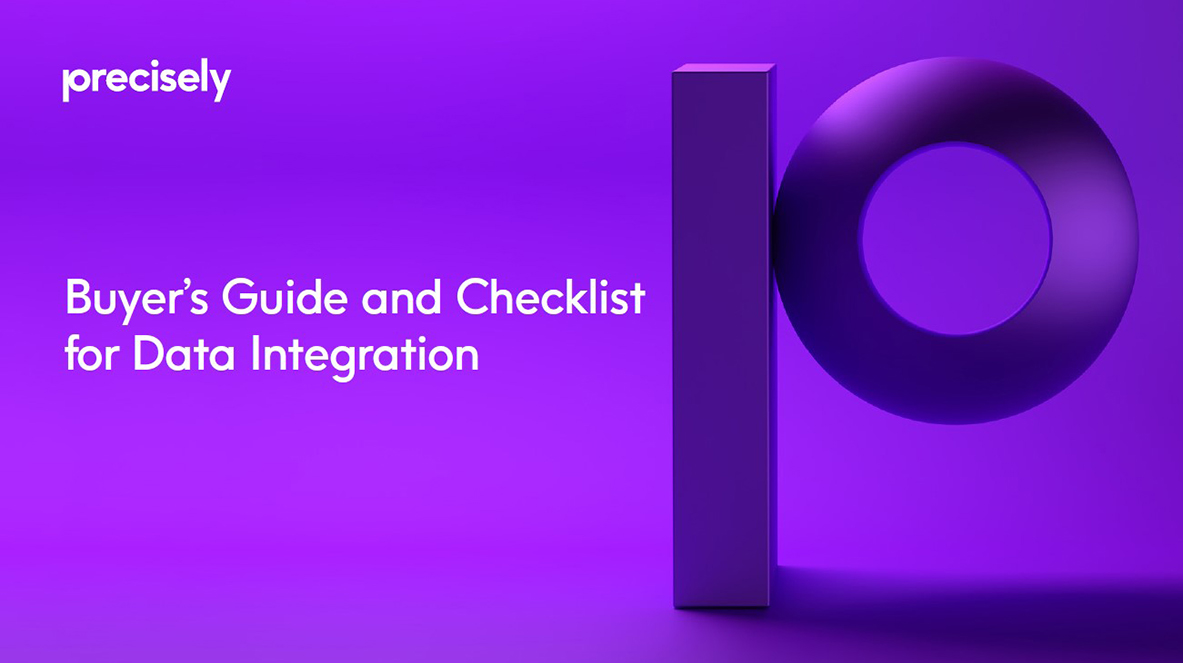eBook
Buyer's Guide and Checklist for Data Integration
Read this eBook to discover 10 key features to help you choose a vendor that offers both software and an approach that can grow and change with your organization, with recommendations on:
- Designing once with a deploy anywhere approach
- Resiliency and backup
- Future proofing investments
Snapshot: The data integration landscape today
Gone are the days of sole batch ETL (extract, transform, and load) with the help of a few skilled developers fulfilling data integration requirements. A new dynamic and fluid model of data integration has taken its place – bringing data from across a business to users when and how they need it. Much of the changed approach is driven by a broader diversity of cloud data consumption models, as well as a surge in the number and types of applications demanding real-time data delivery. Not to mention the all-consuming interest in leveraging generative AI and AI models from organizations across industries.
Cloud delivery models and applications have become part of every organization’s strategic business strategy, allowing them to expand capabilities, reduce costs, and drive digital transformation. However, bringing the right data from existing infrastructure to the cloud for business consumption can be an impossible task for many organizations. Cloud, and the benefits that it promises, requires a new way of thinking about data integration.
As a data integration leader in your organization, you can leverage moving to cloud as an opportunity to modernize existing integration approaches while maximizing your investment in your chosen infrastructure. To modernize, you cannot merely “copy” and “paste” existing data integration pipelines – traditional data pipelines are not adaptive enough. Instead, looking for tools that can build links between existing infrastructure and new cloud investments in an environment-agnostic, future-proof way is imperative. You need only look at what’s transpired over the past ten years to understand why.

The rise of Hadoop and its broad array of on-premises offerings helped organizations to replace their traditional enterprise data warehouses. The early 2010s saw MapReduce fall to Spark and the introduction of an entirely new programming paradigm altogether. Shortly after that, a variety of managed Spark offerings from vendors like Databricks, AWS, Azure, and Google Cloud Platform promised improved agility and scalability at lower TCO. Successfully navigating these waves of revolution requires software that allows you to build integration frameworks that work seamlessly across multiple environments.
The rise of the cloud data warehouse has brought with it promises of unlimited scalability, unrivaled user concurrency, zero administrative overhead, and improved data sharing across the organization. Delivering on these promises requires data pipelines to provide access to information around the business, including legacy systems such as mainframe and IBM i.
And now, with the rise of Generative AI, companies are looking to transform virtually every aspect of organizational operations, from improving efficiency and customer experiences to driving innovation and competitive advantage. However, it runs the risk of producing biased, inaccurate results if it is being fed incomplete, stale, or irrelevant data. Because of this it is critical for organizations have a data integration strategy that allows them to train their AI models on relevant and critical datasets – including critical on-premises data sources like the mainframe, Oracle, and SAP. Investing in data integration software that can natively connect to both cloud and legacy sources is imperative.


That said, data integration nirvana isn’t just connecting data from legacy platforms to the cloud, or providing a centralized source of all data – it’s also about delivering data in real-time. As the speed and volume of transactions accelerate to support your business, data is continuously generated, accessed, processed, and stored across your entire IT landscape – much of it containing latent, unmined insights. To realize the full value of your all your data, it must be provided to users, applications, and data consumers downstream, when and where it’s needed. To do this, your data integration tool must include real-time replication capabilities. The software should be able to communicate changes to data, regardless of the data source or target, without negatively impacting the performance of the source transactional systems via intrusive triggers.
Whether or not you already have a set of data integration tools, what follows is a checklist designed to help you evaluate data integration vendors and software that will help you meet the challenges of the new data integration paradigm, while complementing and optimizing both current and future investments.
Buying the right data integration solution
A checklist for choosing the best vendor and software for your organization’s needs
Checklist for client-vendor partnership
This checklist has been created to help you to analyze data integration vendors and their offerings. It should help you to determine the software solution that is right for your organization. Regardless of your choice, the purpose of this check list is to build the best client-vendor relationship that help you meet your goals.

Where to start
When working with any vendor, you should know exactly what you are, and are not, getting. As you begin to consider different vendors, make sure to evaluate the following.
Strategic direction
Ask where the vendor is headed. Are they taking steps to ensure they are innovating with the times? Understand how they address cloud, advanced analytics and machine learning integration requirements. Find out about their strategy and approach to delivering the latest features and capabilities to customers.
Partnership
A vendor should not only supply software but be a partner in your data integration transformation. Determine the willingness of vendor to partner with you to understand your unique business or technical needs.
Flexibility with existing investments
Don’t be shy. Ask lots of questions about how the vendor can integrate into your existing environments and technology stack. Discuss your specific environment and what you need to get done.
Industry contributions
Make sure you’re working with a leader, not a follower. Ask about vendor contributions to the wider technology landscape, as they are more likely to provide deeper integration and support for the rapidly evolving tech ecosystem.
Demos and references
Ask for demos and customer references. Talk to industry experts; get their recommendations.
Training and support
From innovative technologies to new employees, there’s always a need for training. Make sure you have access to the continued support you need.
10 Key features to look for
Data integration solutions can remain in place for years. The following checklist can help you choose a vendor that offers both software and an approach that can grow and change with your organization.
Wide support for enterprise-grade sources and targets
VSAM. COBOL copybooks. JSON. Cloud data warehouses. Kafka. The list goes on. A vendor should have technology to support a wide range of enterprise data sources and targets for all your ETL and CDC needs.
Exceptional performance and scalability
Look for software that scales to accommodate growing volumes of data, users, and unpredictable peak usage demands. Ask vendors how they deliver both predictable performance and scalability.
Quickly and easily add sources or targets
The software should let you quickly respond to new requirements with ease. Users should be able to add sources and targets at the click of a button. Ask about the process and amount of time required to add new or existing sources and targets.
Resiliency and backup
Data integration software should help you focus on your business, not your systems. Ask how vendor solutions provide data delivery resiliency and back up in the event of a service disruption. Understand if manual coding or tuning is necessary for bringing systems back online.
Tech stack integration
Can the vendor easily integrate their products into your existing technology stack? Ask the vendor if they have certified and proven solutions with technology leaders (ex. Cloudera, Databricks, Snowflake, and more).
Proper security and governance
Ask how data is protected when moving through the data pipeline. Ask about the data governance controls in place to ensure compliance throughout the data pipeline. A vendor should be able to present proof of secure data transfer and have integrations with top security software to provide data protection.
Ease of deployment
An experienced vendor should offer solutions that enable quick deployment. Make sure you understand what to expect around both deployment and support. The deployment should in no way slow down your operations. Always check references.
Future proof investments
You shouldn’t need to continually throw resources at complex deployments (ex. integrations across cloud, hybrid, or on-premises environments). The software you choose should take a development approach that helps insulate you from future technology requirements and disruption without coding, tuning, or redevelopment work.
Design once, deploy anywhere approach
Look for vendors with a record of providing customers with a path to new platforms without bringing down users or service interruptions. Ask how much work is involved when moving from one platform to another. The software should support a variety of platforms and enable movement between platforms with no manual intervention.
Fast time to value
Implementation of data integration software should not increase tech stack bloat. Deployments should require no specialized skills, be resource-efficient, and targeted to your use case. Dig into the ease of use of a vendor offering to ensure you are getting the fastest time to value possible.
Precisely Connect helps you integrate data seamlessly from legacy systems into next-gen cloud and data platforms with one solution.